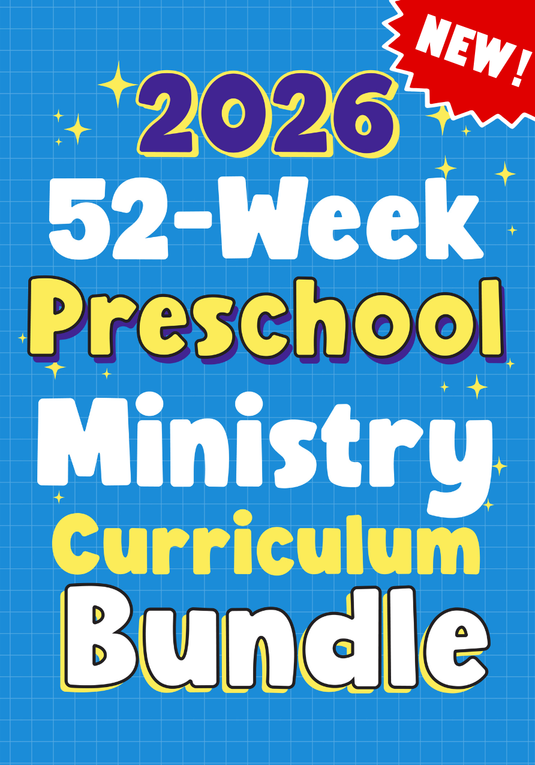As believers, we know that prayer is the tool that gives us access to God. Because we are called to reach children with the hope of the gospel, one of our primary responsibilities is to teach them how to pray, so they learn how to develop their relationship with God outside of our classrooms. Today we will look at some great ways to establish sticky prayer habits at different ages and stages.
Babies
One of the most common mistakes parents make when it comes to the spiritual lives of their children is waiting too long to start. From the moment of conception, a baby’s spirit is being formed. This means that the words were spoken over them matter. One way to help parents learn this is by spending time in the nursery, praying over the infants during routine care times like diaper changing and feeding. Encourage parents to start building into their lives the habit of praying over their children. Throughout their lives, children will learn good prayer habits through their parents' behavior, which starts early.
Older babies start to learn schedules within the first year. This early stage of life is filled with repetition, all of which can be a great starting ground for forming the habit of prayer. Imagine the impact over the life of that child if a prayer accompanied every diaper change!
Toddlers
The toddler years can be rough. But they can also be amazing. As children are learning about the world around them, this can be a great time to start establishing prayer as a regular part of their day. Encourage parents to go beyond meals and bedtime for prayers.
The development of large motor skills at this age brings with it lots of tumbles and falls as they learn to walk and gain their balance. There is an opportunity in that space to teach children about who Jesus is as a comforter and healer. Teaching them a simple prayer asking Jesus to heal their hurts or bring them comfort can build a foundation that teaches them about aspects of the character and nature of God at a heart level long before they can understand them at an intellectual level. As toddlers are in our care, we can model how to pray each time they get a “boo-boo” or are frustrated, which is quite often at this stage. Routine times at home, such as toothbrushing or even bath time, can also serve as ways to build prayer into their routines. Consistency is key.
Preschoolers
At the preschool stage, children love to inspect and explore with their bodies. Take advantage of this natural interest by using their own hand as a way to teach them to pray. Point out that they have five fingers, then teach them a simple 5-word statement that their fingers can help them remember to pray about.
Example: Unfolding one finger at a time, share one word per finger:
(Thumb)-God
(Pointer)- Will
(Middle)- Never
(Ring)- Leave
(Pinky)- Me.
Pray- Thank you God for never leaving me.
This can be used to teach a variety of 5-word promises and prayers. Getting creative by using each hand and even each foot for different prayers is a great way to help preschoolers learn how to develop prayer habits that they can remember.
Elementary
When children reach elementary age, it’s also a common time for worries and anxieties to start to surface. One way to combat this is with a worry box. Using an ordinary shoebox decorated and covered with some key scriptures, provide children with some notecards and explain how God wants to care for us in our fear. Writing down the worry/anxiety/fear and placing the card in the box can be a physical reminder that we can take these kinds of things to God. As they do, remind them to give their worries to the Lord in exchange for the peace that only He can provide. Getting in the practice of taking our concerns to the Lord can be a “sticky” habit that lasts a lifetime.
As children this age start to move towards independence, it’s a good time to help them move from self-centered prayer to other’s-centered prayer. Providing monthly prayer focus cards that they can keep on their fridge or in their room can be a tool to help them start to learn about the world around them.
Examples:
- Prayer for missionaries sent from your church
- Prayer for local homeless populations
- Prayer for the leaders in their lives
- Pick something relevant to them, or even ask them for suggestions!
Tweens
Once children reach the “tween” stage, before they can drive, parents often get stuck in the “uber” stage of parenting which includes a lot of car time with their kids. Instead of looking at this as a chore, encourage parents to use that quiet time to pray with their kids. The routine of car rides to and from school, ball games, and friends' houses can become a point of connection both with their parents and with God if they allow it. Starting this habit early can be so helpful and will often allow glimpses into the heart of a child when they would otherwise be silent or even pull away. At this stage, kids are learning who they are in the world and where they fit in. Encourage families to use this time wisely instead of defaulting to the automatic setting of silence or being on their phones. If tweens won’t pray? It’s ok. Parents can still pray over them. Even if they won’t admit that they like it, it still speaks love in a way that lasts.
Teens
Drama and trauma can become the relationship background for many teenagers. They are getting ready to launch into the world, and this age includes some heavy transitions. The stress of that combined with newly forming friendships and sometimes romantic relationships can leave teens grappling with some powerful emotions. Teaching teens to pray through these times as opposed to giving in to their emotions can be tricky. Even when they don’t look like they are paying attention, teens often are observing the world around them and how the adults in their lives handle transitions. New tools to teach them at this age could include things like prayer journaling or prayer walks. Allowing teens to have the space to be mad at God, to come to Him in their highs and lows, will set the standard for future transitions in their lives. Praying through their questions about faith together can enable them to see that we as adults do not have it all figured out, but we know the one that does.
Rachael Groll has taught kids sticky prayer strategies as she served in Children’s Ministry in Pennsylvania. You can connect with her on her blog She Hears.





